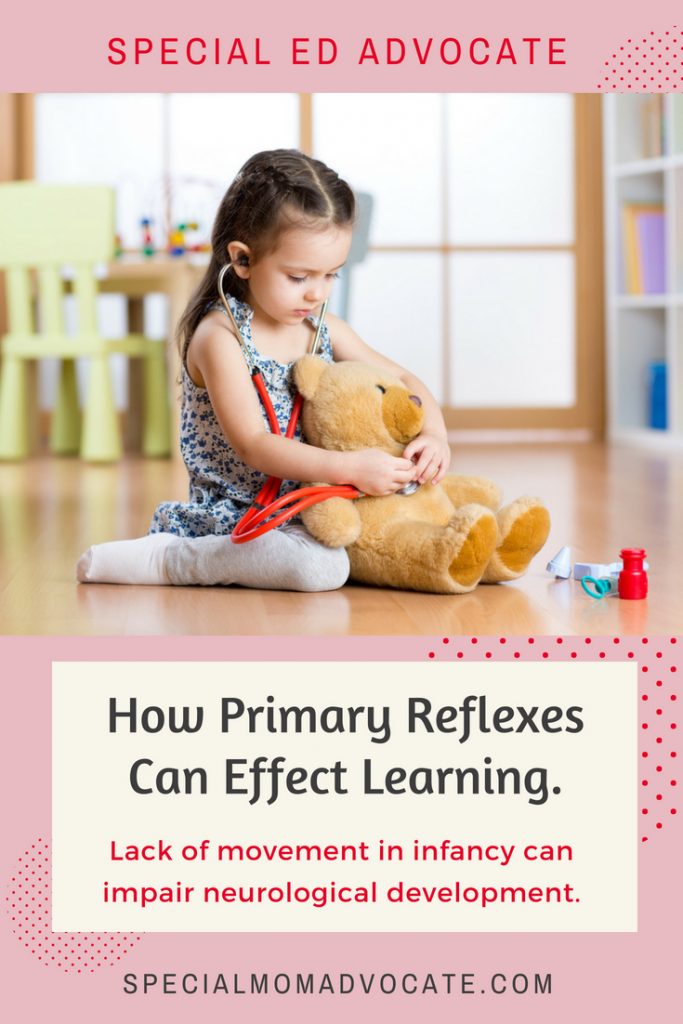 Primary reflex integration has quickly become one of the standard therapies to help children with ADHD, sensory processing, learning disabilities, autism and behavioral problems. It is an exercise-based therapy that helps recreate early baby movements that then help the brain’s neurology to develop missing connections.
Primary reflex integration has quickly become one of the standard therapies to help children with ADHD, sensory processing, learning disabilities, autism and behavioral problems. It is an exercise-based therapy that helps recreate early baby movements that then help the brain’s neurology to develop missing connections.
I learned about primary reflexes nearly 10 years ago when on an intuitive hunch I flew to Seattle to take a course from Sonia Story, one of the leading experts on primary reflexes in the USA. I came home with a toolbox of new knowledge that helped me understand that not crawling had been seriously detrimental to my son’s development. I also learned there were many other critically important movement patterns which come before crawling.
I used what Sonia taught me to implement a movement program that was playful and helped my son be calmer, more focused and more aware. To me primary reflex integration is one of the cornerstone therapies that all parents of special needs children should know about. His sleep, expressive speech and learning greatly improved!
What are primary reflexes?
When a baby moves, those movements are helping to develop the baby’s brain. For example, when you are feeding a baby and put a finger into the baby’s hand, the baby will automatically curl her fingers around your finger. This is called the Grasping Reflex, and it is an automatic response from the baby’s body.
Once the baby’s hand has done this response enough times, the neurology has been established, and the reflex is said to be integrated. Once integrated, the baby can move onto further neurological development of hand coordination. If the baby’s Grasping Reflex is not stimulated enough, the neurology does not develop, and the baby will likely exhibit development issues as a result. An unintegrated Grasping Reflex can cause writing difficulties, speech issues, toe walking, and other challenges.
Before and after primary reflex integration. Look how much she calmed down!
Real life case examples of the positive impact of Primary Reflex Integration.
 How can you integrate primary reflexes?
How can you integrate primary reflexes?
There are several therapies that focus on recreating infant movements as a method for integrating primary reflexes. Several methods have popped up, including the Musgatova Method, Rhythmic Movement Training and Move To Learn.
All the methods have some similarities but differ in timing and exercises that they include. The exercises are usually done 20-30 minutes a day, 5 days a week. It takes several months to see noticeable changes in bigger challenges, but often the exercises themselves are calming for the child, so there is an immediate benefit.
You can do primary reflex integration to help your child!
 You can easily be trained in the integration methods so you can help your child with unintegrated reflexes.
You can easily be trained in the integration methods so you can help your child with unintegrated reflexes.
Sonia Story from Move, Play, Thrive teaches a Brain and Sensory Foundation class, where you can learn what the primary reflexes are, how they affect your child and how to assess for unintegrated reflexes. Sonia also guides you through the process of implementing a movement program to integrate the reflexes in your child. She teaches online classes and in-person classes. She has enrollment for online classes 3 times a year, and right now enrollment is open until May 31, 2018.
Primary reflexes could be the key to seeing your child improve!
Over and over I have witnessed the joy of parents who watch their child improve after doing these very simple exercises. It’s an amazing thing how movement is so vital to proper neurological development. If you have seen little progress with the schools’ alternative teaching methods, I highly encourage you to investigate primary reflex integration. It is truly one of the best approaches to helping ensure your child’s neurology is optimized for development and learning.
NOTE: This blog post contains affiliate links.
ABOUT THE AUTHOR:
Bonnie Landau is a professional counselor and holistic therapist in Ventura County, California. Her specialities include therapy for autism, therapy for ADHD, and therapy for parenting who have kids with autism or ADHD or other neurodivergence. She changed careers from graphic design to counseling with the goal of helping struggling parents of kids with ADHD, autism, or other neurodivergence find strategies and solutions to help their children succeed. Bonnie is also the author of Special Ed Mom Survival Guide: How to Prevail in the Special Education Process and Find Life-long Strategies for You and Your Child.



